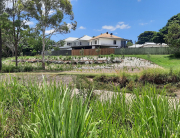Stormwater Queensland believes that the current Queensland regulatory framework for rainwater tanks wastes an opportunity to maximise the use of stormwater that would simultaneously decrease the demand for expensive new water infrastructure and improve water security.
Currently, rainwater tanks (or other supplementary water supply systems, such as greywater treatment plants) are not mandatory for new dwellings/commercial buildings unless a local government has been approved to ‘opt-in’ to Queensland Development Codes (QDC) provisions 4.2 and 4.3. The opt-in process is sufficiently complex to discourage local governments from taking this pathway.
Consequently, communities across Queensland currently experience the following effects:
- Ongoing damage to our waterways (creeks, rivers, bays and the reef). Rainwater tanks can reduce both water quality and hydrological impacts of urbanisation on receiving waterways;
- No reduction in nuisance flooding. Rainwater tanks can aid flood mitigation thereby protecting local homes, business, services and infrastructure;
- Higher demand on reticulated water supply and associated existing infrastructure. Rainwater tanks provide an alternative water source;
- Higher demand for new water supply infrastructure. Rainwater tanks can both offset the demand for new infrastructure and reduce the scale/costs of future infrastructure;
- Limited water security options for individual households. Rainwater tanks increase resilience to climatic pressures including drought.
Changing the Queensland Development Code has the potential to minimise the negative effects and missed opportunities outlined above.
Currently, there are two options which exist for the current regulatory framework as outlined below.
Option 1
Reinstate a performance outcome in the Queensland Development Code mandating supplementary water sources (e.g. rainwater tanks) be required on all new developments with class 1 or commercial buildings, with mandatory plumbing for both internal and external uses. This option is recommended by Stormwater Queensland for the following reasons:
- It provides a balance between the benefits of installing rainwater tanks and the direct building costs;
- The changes to policy are simple and easy to implement (effectively this would require simply reverting to the pre-2013 wording of the QDC);
- It helps to address all the matters discussed above including reducing impacts on waterways, reduced nuisance flooding, reduced demand on potable water infrastructure and improved water security.
Option 2
The ‘do nothing’ approach i.e. maintaining the status quo (no change to policy) Stormwater Queensland believes that is not an acceptable option, for the following reasons:
- This option will result in the continuation of the current problems and missed opportunities outlined above.
- The cost benefit analysis which was used as the basis for removing mandatory rainwater tanks from the QDC in 2012/2013 was later found to be based on several flawed assumptions which compromised the conclusions of that analysis.
- Significantly more research into rainwater tanks has been undertaken since the aforementioned cost benefit analysis was published. This research further provides a much greater body of evidence which Stormwater Queensland believes justifies the adoption of rainwater tanks, demonstrating that rainwater tanks are both cost-effective and safe.
To change the current regulatory provisions and capitalise on the benefits of rainwater tanks, the State is encouraged to undertake the following action by Stormwater Queensland:
- Undertake a review of more current research into rainwater tanks particularly with respect to the costs and benefits.
- Use the outcomes of the analysis as justification for reinstating the pre-2013 wording of the Queensland Development Code mandating supplementary water sources (e.g. rainwater tanks) be required on all new developments with class 1 or commercial buildings, with mandatory plumbing for internal and external uses.
The proposed changes to the regulatory framework are simple and inexpensive to change.
Have Your Say
Take our short survey and have your say on this issue. All responses are confidential and will be used to help Stormwater Queensland with our ongoing advocacy for our industry.








Leave A Comment
You must be logged in to post a comment.